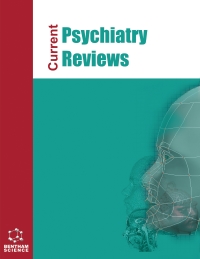- Home
- A-Z Publications
- Current Psychiatry Reviews
- Previous Issues
- Volume 8, Issue 1, 2012
Current Psychiatry Reviews - Volume 8, Issue 1, 2012
Volume 8, Issue 1, 2012
-
-
Preface
More LessThis issue marks the beginning of the eighth year of Current Psychiatry Reviews and it is hard to believe that the time has passed so quickly! Thinking back to our beginning efforts in 2004-05, our overarching goal was to fill a major void in the psychiatric literature, namely to become the first journal devoted to rapid publication of comprehensive reviews of the most interesting and important topics in psychiatry, psychopat Read More
-
-
-
Antidepressants and Sleep: Neurophysiology and Clinical Correlates
More LessIntroduction: Depression is a common disorder associated with significant disability and is a substantial burden on the individual, their relatives and friends, and on society as a whole. Sleep disturbances are key features of depressive symptomatology, with more than 80% of depressed patients complaining of poor quality sleep Methods: The range of available antidepressants is here reviewed in relation to mechanisms of action Read More
-
-
-
Inside the Neurobiological Complexity of Antisocial Personality Disorder
More LessAntisocial personality disorder (ASPD) is a pervasive condition among youngsters around the globe, which has particular pungency in countries where the socioeconomic context favors delinquency. Several behavioral genetics studies have linked the disorder to the presence of copies of a polymorphic variation of the MAO-A gene that leads to enzymatic hypofunction. An emerging tendency in this literature is to also associ Read More
-
-
-
The Neuropsychopharmacology of Pathological Gambling
More LessAuthors: Kourosh Zakeri and Marc N. PotenzaPathological gambling (PG) is an impulse control disorder with prevalence estimates in the range of 0.2-2% in the general population. PG can significantly impact one's ability to function as it may negatively influence social, financial, and occupational aspects of life. Historically, PG has received relatively little attention from researchers and clinicians, and few treatments, particularly pharmacological, have been both vali Read More
-
-
-
Systematic Review and Meta-analysis of Pharmacological Interventions for Weight Gain from Antipsychotics and Mood Stabilizers
More LessPharmacological treatments for serious mental illness (SMI) can cause weight gain and adverse metabolic effects. Many second generation antipsychotics and mood stabilizers appear to be particularly problematic in this regard. Several studies have investigated interventions for antipsychotic-induced, or less commonly mood stabilizer-induced, weight gain. Both lifestyle and pharmacological interventions have de Read More
-
-
-
Are We There Yet? The Clinical Potential of Intranasal Oxytocin in Psychiatry
More LessAuthors: Jean C. J. Liu, Rebecca A. McErlean and Mark R. DaddsThe hormone oxytocin plays a major role in relationship formation and social functioning in animals and humans. We review theory and research examining the potential for intra-nasal oxytocin as an adjunctive medication for several mental health problems and risks: autism, schizophrenia, developmental precursors of psychopathy, social phobia, anorexia nervosa, obsessive compulsive disorder, depression (especially postn Read More
-
-
-
Second-Generation Antipsychotic Agents: A Review of Safety Profiles
More LessAuthors: Vladimir Yurkov, Sarita Jha, David M. Collins and Silvia Alessi-SeveriniEarly clinical trials had suggested a better safety profile for the second-generation antipsychotics (SGAs; e.g. risperidone, olanzapine, quetiapine, aripiprazole) compared to the older first-generation agents (FGAs; e.g. haloperidol and phenothiazines); however, new long-term studies have determined that important adverse events are associated with the use of the SGAs and that their safety profiles differ significantly. This Read More
-
-
-
Bulimia Nervosa and Alcohol Use Disorder: Evidence for Shared Etiology and Neurobiology
More LessAuthors: Zeynep Yilmaz, Allan S. Kaplan and Laurie A. ZawertailoBulimia nervosa (BN) is a serious eating disorder characterized by recurrent binge eating episodes and dysfunctional compensatory behaviours, with a prevalence rate of up to 3%. Epidemiological studies show that BN and alcohol use disorder (AUD) co-occur very frequently in both clinical and community settings. Considering that eating disorders with comorbid AUD are associated with serious medical complications, poor t Read More
-
Most Read This Month
Article
content/journals/cpsr
Journal
10
5
false
en


